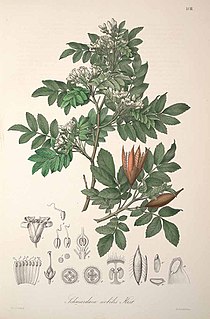The Field Elm cultivar Ulmus minor 'Microphylla Pendula', the Weeping small-leaved elm, was first listed by the Travemünde nursery, Lübeck, and described by Kirchner in Petzold & Kirchner's Arboretum Muscaviense (1864), as Ulmus microphylla pendulaHort.. By the 1870s it was being marketed in nurseries in Europe and America as Ulmus campestris var. microphylla pendula.
Juniperus coahuilensis, commonly known as redberry juniper, is a species of conifer in the family Cupressaceae.
Pinus praetermissa, commonly known as McVaugh's pine, is a species of conifer in the family Pinaceae. Originally classified as a variety of Pinus oocarpa in 1909, it was promoted to specific status in 1990 after further study.
Mutisia microphylla is a species of flowering plant in the family Asteraceae. It is found only in Ecuador. Its natural habitats are subtropical or tropical moist montane forests and subtropical or tropical high-altitude shrubland. It is threatened by habitat loss.

The San José brush rabbit is a species of mammal in the family Leporidae.
Tritocleis is monotypic moth genus in the family Geometridae described by Edward Meyrick in 1899. Its only species, Tritocleis microphylla, the ʻOlaʻa peppered looper moth, described by the same author in the same year, is now extinct.
Aerva microphylla is a species of plant in the family Amaranthaceae.
Anthocleista microphylla is a species of plant in the family Gentianaceae. It is found in Cameroon, Equatorial Guinea, Ghana, Nigeria, and São Tomé and Príncipe. Its natural habitat is subtropical or tropical moist lowland forests. It is threatened by habitat loss.
Cameraria microphylla is a species of plant in the family Apocynaceae. It is endemic to Cuba. It is threatened by habitat loss.
Madhuca microphylla is a species of flowering plant in the family Sapotaceae. It is endemic to Sri Lanka, where it has been found in only two locations.
Mahonia microphylla is a shrub in the Berberidaceae first described as a species in 1999. It is endemic to Guangxi Province in China.
Polylepis microphylla is a species of plant in the family Rosaceae. It grows in the Andes of Ecuador and Peru.
Ruagea membranacea is a species of plant in the family Meliaceae. It is endemic to Ecuador.

Ruagea is a genus of plants in the family Meliaceae. It contains the following species :
Ruagea ovalis is a species of plant in the family Meliaceae. It is endemic to Bolivia.
Saurauia microphylla is a species of plant in the Actinidiaceae family. It is endemic to Java in Indonesia.

Schmardaea is a genus of trees in the family Meliaceae. It solely comprises the species Schmardaea microphylla.

Lunugamvehera National Park in Sri Lanka was declared in 1995, with the intention of protecting the catchment area of the Lunugamvehera reservoir and wildlife of the area. The national park is an important habitat for water birds and elephants. The catchment area is vital to maintain the water levels of the five tanks in the down stream of Kirindi Oya and wetland characteristics of Bundala National Park. This national park also serves as a corridor for elephants to migrate between Yala National Park and Udawalawe National Park. The national park is situated 261 km (162 mi) southwest from Colombo. After being closed because of the Sri Lankan civil war, the national park is now open to the general public.

The World's 25 Most Endangered Primates is a list of highly endangered primate species selected and published by the International Union for Conservation of Nature Species Survival Commission Primate Specialist Group, the International Primatological Society (IPS), and Conservation International (CI). The 2012–2014 list added the Bristol Conservation and Science Foundation (BCSF) to the list of publishers. The IUCN/SSC PSG worked with CI to start the list in 2000, but in 2002, during the 19th Congress of the International Primatological Society, primatologists reviewed and debated the list, resulting in the 2002–2004 revision and the endorsement of the IPS. The publication has since been a joint project between the three conservation organizations and has been revised every two years following the biannual Congress of the IPS. Starting with the 2004–2006 report, the title changed to "Primates in Peril: The World's 25 Most Endangered Primates". That same year, the list began to provide information about each species, including their conservation status and the threats they face in the wild. The species text is written in collaboration with experts from the field, with 60 people contributing to the 2006–2008 report and 85 people contributing to the 2008–2010 report. The 2004–2006 and 2006–2008 reports were published in the IUCN/SSC PSG journal Primate Conservation, while the 2008–2010 and 2010-2012 report were published as independent publications by all three contributing organizations.





